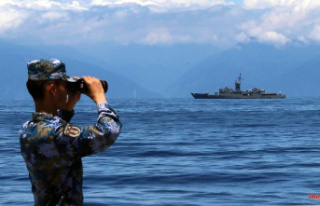Russia shells civilian installations in the Ukrainian hinterland. A massive air strike hits the dam near Kryvyj Rih, the barrage is damaged. The dammed water masses flood the valley of the Inhulez - and also causes difficulties for Russian troops.
The Russian attack with cruise missiles against the dam at Kryvyi Rih could prove to be a catastrophic failure. According to Ukrainian sources, the impact of the Russian shells on Thursday night damaged parts of the dam wall of the Karachunivka reservoir. The escaping water masses led to flooding below the barrage in the valley of the Inhulez. The tidal wave caused the level of the Inhulez River to rise sharply.
The reservoir is in the immediate vicinity of the regional metropolis of Krywyj Rih, which has 600,000 inhabitants, and is used, among other things, to supply drinking water. The dam, which impounds the water of the Dnipro tributary Inhulets, is clearly part of the civilian infrastructure. Even the road that leads over the dam obviously has no supra-regional importance. A railway viaduct nearby was apparently not damaged in the attack. A direct military benefit of the air attack is not discernible. Did the Kremlin's strategists deliberately want to destroy the supply of the city of Kryvyi Rih?
The Ukrainian side sees the massive air strike as a terrorist attack against the civilian population. Ukrainian President Volodymyr Zelenskyy, a native of Kryvyi Rih, said Russian forces had attacked hydrotechnical infrastructure to "flood" his hometown. In the hours following the explosions at the dam, there was a risk of flooding in the center of the city, particularly in the residential areas bordering the Inhulez.
A random hit seems impossible: the dam was hit by a whole volley of superheavy projectiles. The governor of the Dnipropetrovsk region, Valentin Resnichenko, spoke of an attack with a total of seven to eight cruise missiles that Russian bombers fired at the city. In addition to the dam, other infrastructure facilities were also damaged.
The first images from Kryvyi Rih show signs of massive explosions, but no deep craters. The actual damage done seems to be limited. Below the dam wall, 112 houses were flooded that night, said the head of the local military administration, Olexander Wilkul, the morning after the attack. So far there have been no reports of injuries or even deaths.
The work to repair the dam started during the night. The dam itself withstood the Russian attack. Emergency services were able to temporarily repair the barrage. The water levels of the Inhulez were reportedly already declining. However, the tidal wave could have consequences further downstream: the Inhulez flows south from Kryvyi Rih towards the combat zone. The heavily winding course of the river forms the front line between Ukrainian and Russian troops over long stretches in the Cherson region.
The masses of water that have escaped from the reservoir near Kryvyi Rih could make crossing the Inhulets more difficult. Both sides also use pontoon bridges on the Inhulez, which can hardly withstand larger tidal waves. For the Ukrainian side, this would be particularly problematic in the town of Davydiv Brid, where the supply routes for one of the main thrusts of the Cherson offensive run across the Inhulets.
However, a major flood on the Inhulez could also be dangerous for the Russian troops. The Inhulets divides the front near Cherson into two sections just before the confluence with the Dnipro. Up until a few weeks ago, the bridge near Darjiwka was still available to the Russians for major transport connections - until Ukrainian precision attacks destroyed it. Since then, a Russian pontoon bridge has crossed the Inhulez. The tidal wave in the Inhulez Valley near Cherson thus also endangered Russian units.












